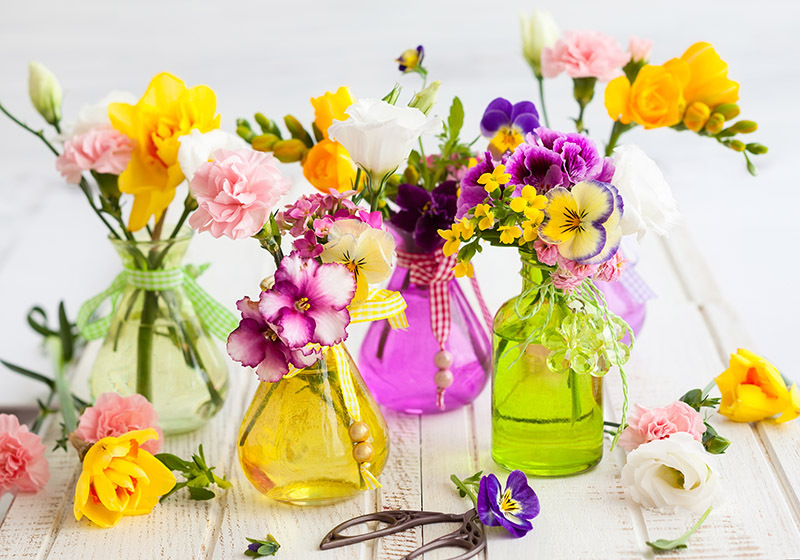Harnessing the beauty of hydrangeas with proper care
Posted on 26/08/2025
Harnessing the Beauty of Hydrangeas with Proper Care: A Comprehensive Guide
Hydrangeas are among the most beloved and versatile flowering shrubs, gracing gardens around the world with their lush, voluminous blooms and captivating color variations. From their romantic, cottage-garden charm to their adaptability in landscape designs, hydrangea flowers offer endless possibilities -- if you know how to cultivate them. Whether you are a beginner gardener or a seasoned enthusiast, understanding the nuances of caring for hydrangeas is essential to unlock their true potential in your backyard oasis.

Understanding Hydrangeas: A Botanical Introduction
Belonging to the genus Hydrangea, these flowering plants come in a variety of shapes and species, including the iconic mophead, lacecap, and panicle types. Hydrangeas are prized for their large, globe-shaped blooms and their unique ability to change color in response to soil pH--especially evident in popular varieties like Hydrangea macrophylla.
Types of Hydrangeas and Their Unique Characteristics
- Hydrangea macrophylla (Bigleaf or Mophead Hydrangeas): Known for their large, ball-shaped blooms and color-changing capabilities. Ideal for creating dramatic displays.
- Hydrangea paniculata (Panicle Hydrangeas): Renowned for their cone-shaped, white flowers that can turn pink as they age. Very hardy and sun-tolerant.
- Hydrangea arborescens (Smooth Hydrangeas): Such as the classic 'Annabelle', featuring round, white flower heads. Well-suited for colder climates.
- Hydrangea quercifolia (Oakleaf Hydrangeas): Noted for their oak-shaped leaves and stunning autumn foliage colors in addition to their conical blooms.
- Climbing Hydrangea (Hydrangea anomala petiolaris): Ideal for walls, pergolas, or fences, with fragrant, lacy white flowers and vigorous climbing growth.
The Significance of Hydrangeas in Modern Gardens
More than just a source of visual delight, hydrangea plants also provide ecological value by attracting pollinators such as bees and butterflies. Their extended blooming season, which often runs from spring to early autumn, ensures prolonged interest in your landscape, while their lush foliage makes a picturesque backdrop even when out of bloom.
Planting Hydrangeas: The First Step to a Flourishing Display
The foundation for lush and vibrant hydrangea blooms begins at planting. Pay careful attention to location, timing, and initial soil preparation to set your plants up for years of spectacular performance.
Choosing the Right Location
- Sunlight: Hydrangeas generally prefer morning sun and afternoon shade, which helps protect their blooms from the hot sun, especially in warmer regions.
- Soil Requirements: Well-draining, fertile soil is crucial. Amending heavy clay or sandy soils with organic matter improves texture and moisture retention.
- Air Circulation: Provide enough space between plants to ensure good air flow and reduce the risk of fungal diseases.
Optimal Planting Season
For most climates, early spring or fall are the best times for hydrangea planting. The cooler months allow roots to establish without the stress of intense summer heat.
Proper Planting Technique
- Dig a hole twice as wide and about as deep as the plant's root ball.
- Mix in compost or aged manure with excavated soil.
- Gently loosen the roots and set the plant at the same depth as it was growing in its pot.
- Backfill the hole, firming the soil around the roots.
- Water thoroughly to eliminate air pockets and jumpstart root establishment.
The Essentials of Hydrangea Care
While hydrangeas are relatively hardy, proper care is necessary to keep them healthy and vigorous. Attention to watering, fertilization, mulching, and pruning translates directly to more abundant, longer-lasting blooms.
Watering Hydrangeas Correctly
Hydrangeas are particularly sensitive to both drought and waterlogging. For optimal hydrangea care:
- Consistency is Key: Water at least once a week, providing a deep soak to reach root levels.
- Monitor Weather: Supplement rainfall during dry spells, particularly in sandy soils.
- Morning Watering: Always water early in the day to reduce evaporation and prevent fungal problems.
- Avoid Overhead Sprinkling: Wetting foliage can encourage disease; aim for soil-level irrigation.
Feeding and Fertilizing for Robust Growth
Fertilization needs can vary by hydrangea type and soil fertility. As a general rule:
- Spring Application: Apply a slow-release, balanced fertilizer in early spring, just as new growth emerges.
- Supplement as Needed: If blooms or leaves appear weak or pale, consider a mid-season feed.
- Avoid Late Feeding: Fertilizing after midsummer can stimulate new growth prone to frost damage.
- Organic options, such as compost tea or fish emulsion, enrich the soil with micronutrients over time.
Mulching for Moisture and Health
Mulch helps conserve soil moisture, regulate temperature, and suppress weeds. Apply a 2-3 inch layer of organic mulch -- like bark chips or compost -- around the base, taking care not to touch the main stem to avoid rot.
Pruning Hydrangeas: Timing and Methods Matter
Pruning hydrangeas can be confusing, as the methods and timing vary depending on the species. Proper pruning is not only about size control -- it's crucial for vibrant flowers.
Pruning Bigleaf (Mophead and Lacecap) Hydrangeas
- Prune immediately after flowering, typically in summer, as these hydrangeas bloom on old wood (last year's growth).
- Remove spent blooms and thin out older, woody stems to encourage new growth.
- Do not cut back drastically in late fall or spring, as this removes next season's flower buds.
Pruning Panicle and Smooth Hydrangeas
- These types bloom on new wood (current season's growth) and are best pruned in late winter or early spring before new growth starts.
- Cut back stems to a healthy pair of buds, or even down to 12-18 inches from the ground for a compact shape.
Oakleaf and Climbing Hydrangeas
- Prune lightly after flowering to control height and encourage branching.
- Remove only dead or weak branches and spent blooms.
Color Magic: Adjusting Hydrangea Blossom Hues
One of the most enchanting traits of bigleaf hydrangeas is their ability to change flower color based on soil pH:
- Blue Blooms: Acidic soils (pH below 6.0) produce blue flowers.
- Pink Blooms: Alkaline soils (pH above 7.0) yield pink flowers.
- Purple/Lavender: Neutral soils may produce lavender hues.
Tips for Influencing Hydrangea Colors:
- To increase soil acidity (for bluer blooms), add elemental sulfur, aluminum sulfate, or pine hay.
- To raise alkalinity (for pinker blooms), incorporate garden lime.
- Changes may take a few months to a season; test soil regularly for the best results.
Common Hydrangea Care Challenges and Solutions
Pest and Disease Management
- Powdery Mildew & Leaf Spot: Ensure good airflow, avoid overhead watering, and remove infected leaves promptly.
- Aphids, Spider Mites, and Slugs: Inspect foliage regularly. Use organic insecticidal soaps or introduce beneficial insects like ladybugs.
- Root Rot: Overwatering or poor drainage can lead to rot -- always provide well-drained soil.
Dealing with Weather Extremes
- Heat Waves: Apply extra mulch and increase watering; consider temporary shade if possible.
- Frost/Cold Damage: Mulch thickly in late fall and protect with burlap wraps or covers in harsh winters.
- Drought: Use soaker hoses or drip systems to keep roots consistently moist.
Propagating Hydrangeas: Grow More from Your Favorites
Hydrangeas are easy to propagate, allowing you to fill your garden -- or share with friends -- for free! The most common methods include:
- Softwood Cuttings: Take a 4-6 inch cutting of new growth in late spring or early summer. Root in moist potting mix under indirect light.
- Layering: Bury a low branch under soil, secure it, and wait several months for roots to develop before severing and replanting.
Tips for Show-Stopping Hydrangea Displays
Landscape Design Ideas with Hydrangeas
- Mass Planting: Group several of the same variety for a bold, uniform effect.
- Mixed Borders: Combine with perennials, ferns, or ornamental grasses for texture and continuous color.
- Foundation Plantings: Use hydrangeas to soften corners or conceal unsightly foundations.
- Container Gardening: Dwarf or compact hydrangea types thrive in large pots on patios or balconies.
Cut Flower Arrangements
- Clip blooms early in the morning for freshest results.
- Immediately submerge stems in cool water to preserve turgidity.
- Hydrangeas also dry beautifully -- hang upside down in a dark, airy room to enjoy blossoms all year round.

Year-Round Hydrangea Maintenance Checklist
- Spring: Fertilize, prune if needed, check mulch, and start regular watering.
- Summer: Continue watering, deadhead spent flowers, and address pests promptly.
- Autumn: Reduce feeding, apply mulch, and prune only where necessary.
- Winter: Protect young or tender plants from frost; plan early for next season's new plantings.
With proper hydrangea care, these magnificent shrubs will reward you with seasons of breathtaking beauty, turning your garden into a floral masterpiece. Whether your preference runs to powdery blue or show-stopping white, a little attention goes a long way. Start harnessing the beauty of hydrangeas today--your garden will flourish for years to come!
Frequently Asked Questions About Hydrangea Care
- How often should I water my hydrangeas? – Water deeply once a week, more often in heat or sandy soil.
- Can hydrangeas grow in pots? – Yes! Opt for compact varieties and use large, well-draining containers.
- Why aren't my hydrangeas flowering? – Possible causes include improper pruning, insufficient light, or nutrient shortages.
- When is the best time to plant hydrangeas? – Early spring or fall is ideal for most climates.
- How do I change the color of my hydrangea flowers? – Adjust soil pH with sulfur (to blue) or lime (to pink), mainly for bigleaf varieties.
Conclusion: Loving Hydrangeas, Reaping Rewards
Hydrangeas are more than just a garden centerpiece--they are a testament to the wonders of nature, adapting their colors and form to reflect the care and passion of their gardener. By implementing the essential tips for harnessing the beauty of hydrangeas with proper care, you set the stage for abundant, healthy blooms season after season. From selecting the right variety to mastering soil pH and pruning techniques, every detail contributes to their magical allure. Embrace the journey, nurture your hydrangeas, and look forward to a landscape bursting with charm and color.
Latest Posts
Office Plant Choices for the Time-Strapped Individual
Sunflower Marvels: 8 Facts That Might Surprise You
Harnessing the beauty of hydrangeas with proper care






